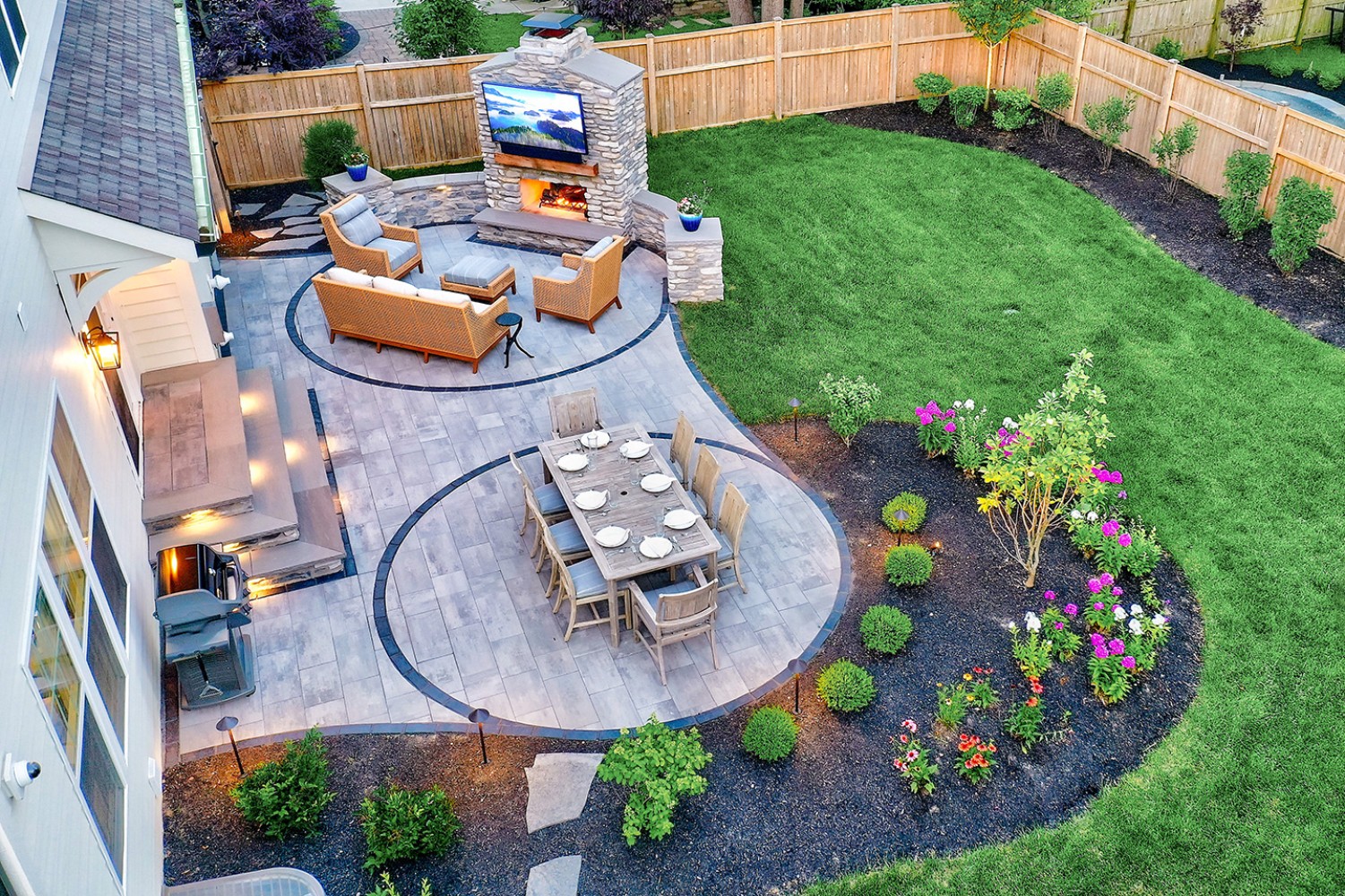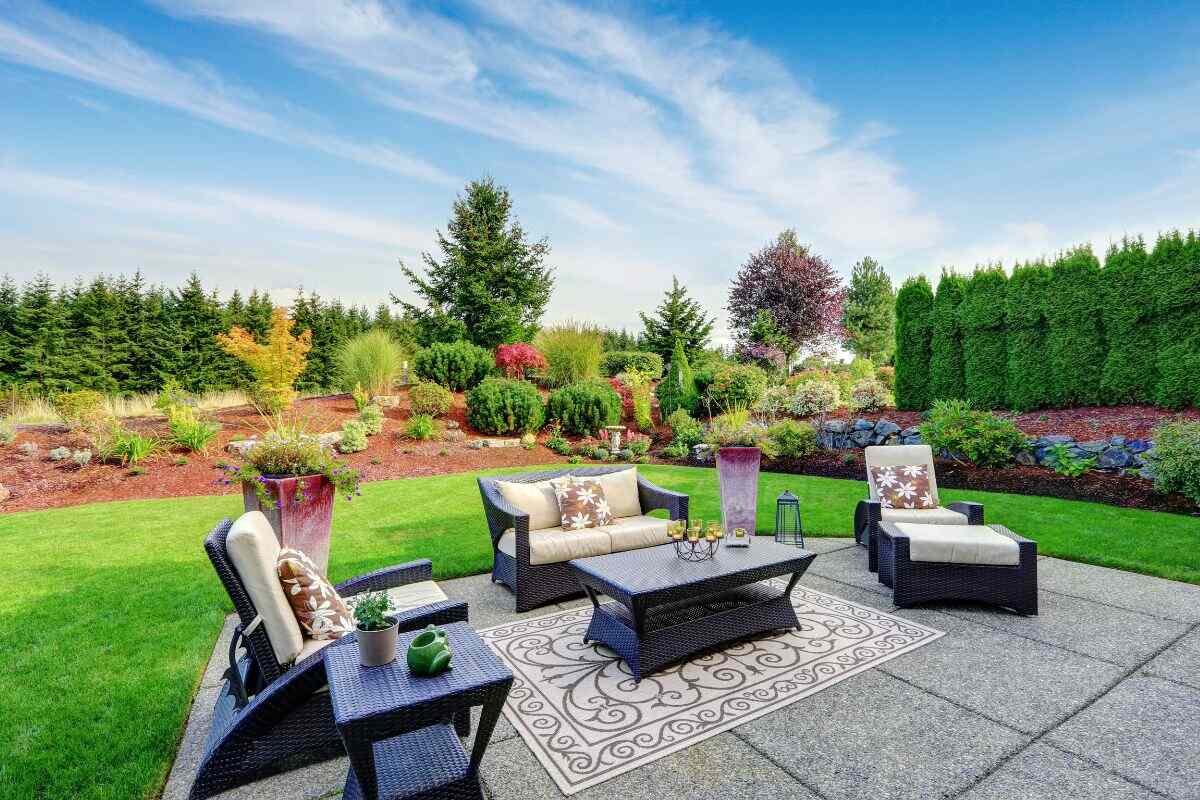Artificial Grass Maintenance Tips to Keep It Looking New All Year
Wiki Article
Change Your Garden With Cutting-edge Landscape Design Strategies and ideas
Transforming a yard requires thoughtful factor to consider of its unique characteristics. Efficient landscape Design can improve both functionality and visual appeal. By checking out numerous methods, one can develop an area that not only reflects individual style yet also sustains neighborhood biodiversity. As the journey unfolds, questions regarding plant choice, sustainability, and design occur, prompting a much deeper exploration right into how to make these concepts come to life.Assessing Your Outdoor Space: Comprehending Your Garden's Prospective
Assessing outside area is important for effective landscape design. Understanding the special attributes of a yard permits developers to optimize its capacity. Variables such as soil quality, sunlight direct exposure, and existing frameworks play an essential duty in establishing what can be attained. Assessing the topography aids recognize locations for growing, courses, or water functions, while keeping in mind water drainage patterns guarantees that plants prosper without waterlogging.Recognizing the yard's microclimates can influence plant choice and placement. Observing exactly how the space is utilized by citizens notifies practical Design selections, such as seating locations or play areas. Furthermore, taking into consideration the surrounding environment and bordering landscapes can give ideas and context for Design choices. By extensively analyzing these components, one can create a natural and welcoming outdoor area that shows the owner's vision while balancing with nature. Eventually, a detailed assessment lays the foundation for a successful landscape Design task.
Choosing the Right Plants: An Overview to Color, Appearance, and Seasonal Interest
When picking plants for a landscape style, understanding the interplay of shade, structure, and seasonal interest is crucial for producing a vibrant and vibrant garden. Color can evoke feelings and established the tone for the area; subsequently, choosing an unified combination enhances visual allure. Warm tones like reds and oranges create power, while cooler tones like blues and eco-friendlies supply harmony.Structure adds deepness and measurement, enabling a mix of foliage sizes and shapes. Incorporating fine-textured plants with bold-leaved ranges develops contrast and intrigue.
Seasonal interest is necessary for maintaining year-round elegance. Selecting a variety of plants that flower in different seasons guarantees that the yard stays dynamic, moving from springtime's lively flowers to autumn's abundant vegetation. By thoughtfully considering these elements, one can curate a landscape that is not only visually pleasing but engaging and additionally varied throughout the year.

Producing Useful Zones: Designing Spaces for Leisure and Entertainment
Producing practical areas in a landscape Design improves the functionality of exterior spaces, enabling homeowners to flawlessly mix relaxation and enjoyment. By thoughtfully separating areas into distinct areas, individuals can accommodate different activities, from quiet hideaways to dynamic celebrations. A properly designed area may integrate a relaxing reading space snuggled among lavish plant, providing a relaxing retreat (Landscape Architect). In contrast, a lively exterior eating location can offer as the perfect setting for events with family and close friendsStrategically positioned pathways can lead guests in between these areas, guaranteeing very easy navigation. Additionally, including components like seating areas, fire pits, or water attributes can enhance the total ambiance and functionality. The assimilation of diverse appearances and shades in each zone can create visual passion while keeping a natural visual. Eventually, creating practical areas enables home owners to optimize their outside experience, transforming their gardens right into functional areas that meet varied way of living demands.
Integrating Hardscape Aspects: Patios, Walkways, and Focal Information
Integrating hardscape elements right into landscape Design matches useful zones by providing framework and visual appeal. Patios function as essential outside living spaces, permitting property owners to delight in meals and celebrations in a specified area while boosting availability. The selection of materials, such as all-natural stone or concrete, can substantially affect the overall aesthetic, mixing perfectly with the surrounding setting.Sidewalks facilitate movement with the yard, directing visitors while including depth and passion. These paths can be crafted from various materials, consisting of crushed rock, pavers, or block, each adding to the garden's personality.
Prime focus, such as decorative stones, sculptures, or water features, draw the eye and produce a feeling of function within the landscape. Purposefully put, these aspects can change a normal garden right into an appealing area, inviting expedition and interaction. Through thoughtful assimilation of hardscape, a landscape ends up being not only useful yet additionally aesthetically stunning.
Enhancing Privacy and Security: Natural Barriers and Structures
To improve privacy and protection in landscape layout, making use of all-natural barriers such as dense bushes can successfully protect a property from undesirable sights. Furthermore, setting up personal privacy fences gives a solid structure that adds to a feeling of safety and privacy. Together, these aspects produce an even more intimate exterior area while discouraging prospective intrusions.Growing Dense Hedges
While many home owners look for aesthetic appeal in their landscapes, planting thick hedges serves a double purpose of improving privacy and security. These all-natural barriers create a visual shield, properly obstructing the view from prying eyes and hindering potential intruders. Various types, such as boxwood, holly, or privet, can be selected for their growth patterns and foliage density, making sure rich protection throughout the year. In addition, well-kept hedges can add to a relaxing atmosphere, absorbing sound and providing an environment for wildlife. The tactical placement of these hedges can define building boundaries and produce secluded exterior spaces, enabling home owners to appreciate their gardens with a feeling of safety. Ultimately, thick bushes are a reliable option for mixing beauty with performance.
Mounting Privacy Fences
Personal privacy fences function as another reliable technique for enhancing privacy and safety and security in residential landscapes. These structures not just define residential or commercial property borders but likewise create a sense of privacy, shielding house owners from prying eyes. Numerous materials, such as metal, wood, and plastic, deal unique aesthetics and degrees of longevity, enabling property owners to choose based upon their Design preferences and maintenance needs.
Sustainable Landscaping: Eco-Friendly Practices for a Greener Garden
Lasting landscape design stresses the importance of native plant option and water conservation methods. By choosing plants that are well-adapted try this out to the regional environment, garden enthusiasts can decrease upkeep and source use. Applying reliable sprinkling methods additionally boosts the garden's eco-friendly advantages, promoting a much healthier community.Native Plant Choice
Indigenous plant selection plays a vital role in lasting landscaping, promoting biodiversity and lowering the need for chemical inputs. By picking plants belonging to a particular area, gardeners can produce habitats that support neighborhood wildlife, such as pollinators, birds, and valuable insects. These plants are adapted to the regional environment and dirt conditions, requiring less water and maintenance contrasted to non-native varieties. Additionally, native plants can aid regulate erosion and improve soil health and wellness, cultivating a well balanced environment. Incorporating native types into landscape creates not just enhances the aesthetic appeal of the yard yet likewise adds to ecological durability. Eventually, native plant selection is a crucial strategy for those seeking to grow a lasting and vivid garden.Water Conservation Techniques
Including native plants can substantially improve water conservation initiatives in landscape design. These plants are well-adapted to regional climates, requiring less water and upkeep than non-native selections. Applying drip watering systems enables targeted watering, decreasing dissipation and drainage. Rain collecting systems can likewise be mounted, keeping and collecting rain for yard use. Mulching helps preserve dirt wetness, minimizing the frequency of watering. Organizing plants with comparable water requires together creates efficient watering zones, additionally conserving water. In addition, using permeable products for pathways allows rain to seep into the ground, replenishing groundwater products. By utilizing these water conservation strategies, garden enthusiasts can create lasting landscapes that grow while lessening environmental effect (Landscaping Contractor). Such techniques add to a greener garden and a healthier ecological communityIndividualizing Your Design: Adding One-of-a-kind Functions and Individual Touches
Exactly how can one change a garden into a personal shelter? Personalizing a landscape Design entails incorporating special functions that reflect private preferences and way of livings. One method is to include individualized garden art, such as sculptures or handmade birdhouses, which can work as prime focus and discussion starters. On top of that, tailoring plant options based upon personal choices or seasonal blooms can develop a lively and evolving space.Creating functional areas, such as a comfortable analysis space or an outdoor dining room, can enhance use and comfort. Integrating components like a fire pit or a water function can introduce a welcoming setting.
Color plans, materials, and textures need to straighten with the home owner's style, whether Get More Info it be modern-day, rustic, or diverse. Eventually, the goal is to create a room that reverberates with the individual's identification, making the garden not just an aesthetic joy however a true expansion of the home owner's character.
Often Asked Questions
How Do I Budget for a Landscape Design Project?
To spending plan for a landscape Design job, one must evaluate task scope, research study prices for materials and labor, prioritize features, and assign an extra 10-20% for unforeseen expenditures, making sure a reasonable economic plan.What Tools Are Necessary for Home Garden Landscaping?
Important devices for home garden landscape design consist of a shovel, rake, garden fork, trimming shears, hoe, trowel, and wheelbarrow. These instruments aid in dirt prep work, planting, maintenance, and reliable transport of materials throughout the landscape design job.Exactly How Can I Keep My Yard After Revamping?
To preserve a redesigned garden, normal watering, mulching, weeding, and trimming are vital (Landscape Architect). Monitoring plant wellness, adjusting dirt nutrients, and seasonal plant care contribute to a successful setting that showcases the yard's new Design effectively
When Is the very best Time to Start Landscaping?

Can I DIY My Landscape Design or Should I Employ a Professional?
Individuals can absolutely DIY their landscape Design if they have creativity and standard skills; nonetheless, working with a professional frequently ensures a much more experienced and natural result, particularly for intricate tasks or particular Design desires.Recognizing the garden's microclimates can affect plant option and positioning. When choosing plants for a landscape design, understanding the interaction of color, texture, and seasonal rate of interest is crucial for creating a lively and vibrant garden. Choosing a selection of plants that bloom in various seasons assurances that the garden stays vibrant, changing from spring's lively read the article flowers to autumn's rich vegetation. Incorporating indigenous varieties right into landscape makes not just boosts the visual allure of the yard yet additionally contributes to environmental strength. Crucial tools for home yard landscape design include a shovel, rake, garden fork, trimming shears, wheelbarrow, trowel, and hoe.
Report this wiki page